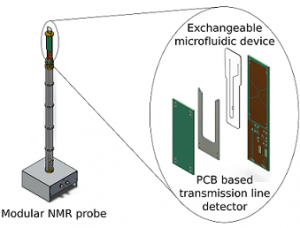Nuclear magnetic resonance (NMR) is an analysis technique which is widely used in physics, medicine and chemistry. As NMR is a non-invasive and non-destructive method, it is used to image soft tissue inside the human body in the form of Magnetic resonance imaging (MRI). Conventional liquid-state NMR spectroscopy is usually performed on 200-800 microliter sample in a 5-10 millimeter diameter tube. Although conventional NMR is successfully used for a variety of applications, many problems cannot be adequately addressed by it. For example, bodily fluids from small animals are usually available in much smaller quantities compared to the sample volumes required by conventional NMR.
Microfluidics is a well-established field for manipulation of small sample volumes in microliter to nanoliter range. Due to small sample volumes, physical conditions for a sample can be precisely controlled with minimum resources. NMR can be used to study these systems for various chemical or biological processes.
Microfluidic systems are usually planar in geometry as oppose to conventional NMR sample holders which are cylindrical in shape. To study microfluidic systems with NMR, new setups tailored to specific needs are required.
We have developed a platform that can study generic microfluidic setups with NMR. This new setup requires 100 times less sample volume compared to conventional liquid-state NMR. The sample is held in a planar microfluidic chip made from plastic materials. The microfluidic chip can be used as a passive sample holder or a flow can be induced to supply different liquids. Gases can be dissolved in liquids on the chip for chemical reaction or oxygen supply to biological systems. The temperature at the chip can be tightly controlled to study different physical conditions. As the chip is placed in the NMR detector all the systems can be studied in real-time in their native environment. The setup has already been used for various experiments including reaction monitoring, micro-imaging of mouse liver tissue slices, and metabolic studies of mammalian cells.
